The full auto Glock 18 can throw a whole lot of lead in a quick hurry. Watch this super slow-motion 600 frames/second video capturing dual Glocks lettin' ‘er rip.
Recommended Glock Resources:
The Gun Digest Book of the Glock, 2nd Edition
The full auto Glock 18 can throw a whole lot of lead in a quick hurry. Watch this super slow-motion 600 frames/second video capturing dual Glocks lettin' ‘er rip.
Recommended Glock Resources:
The Gun Digest Book of the Glock, 2nd Edition
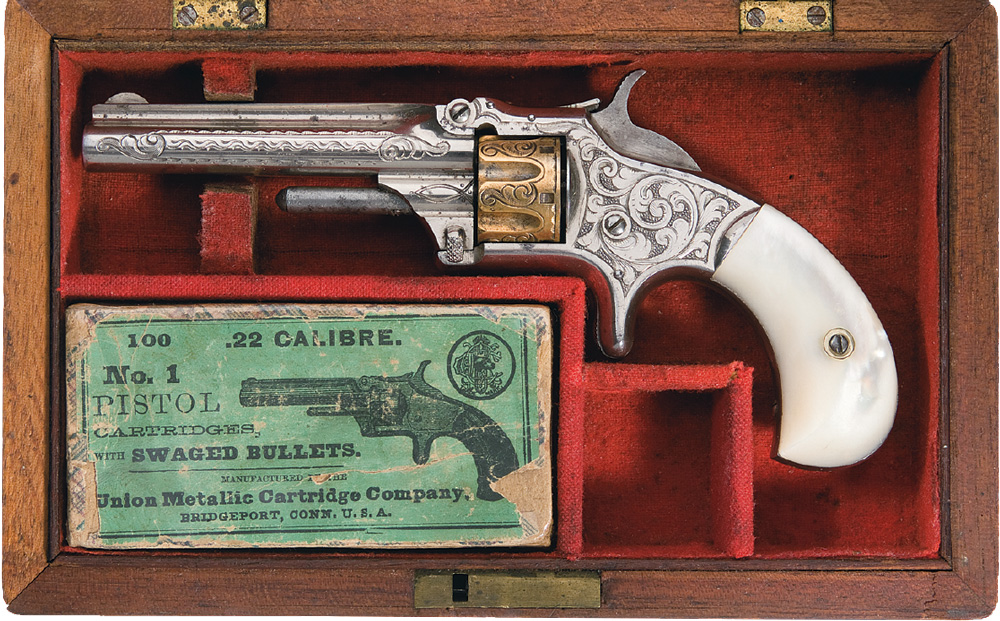
The percussion purist may laugh, but consider the antique .22-cartridge revolver. In that field, $700 will buy 20 or more guns, these covering the period from the first American cartridge revolver, made in 1857, through the 1890 models that have most of today’s modern revolver features.
The typical .22 antique cartridge revolver is a compact seven-shot arm with a 2- or 3-inch barrel and hardwood, bird’s-head grips. They’ll weigh about 10 ounces, their length a little over 6 inches. Most were made to fire a .22-caliber Short, but not the .22 Short we know now. The smokeless powder of today is too powerful for your antique .22 so don’t ever try it.
The story of the small revolvers began in 1854 with the patent of a metallic cartridge by Horace Smith and Daniel B. Wesson. To enable them to manufacture a revolver for this cartridge they had to acquire the patent of Rollin White, a former Colt employee, who held a patent issued April 3, 1855, for a bored-through cylinder to accommodate the breech loading of cartridges.
Rollin White had tried unsuccessfully to sell the rights to Colt. These patents and subsequent improvement patents gave Smith & Wesson (S&W) the sole right to the breech-loading cartridge revolver market for 12 years, until the expiration of those rights in 1869. During this period, S&W produced some 126,000 .22-caliber revolvers in three variations of the model No. 1, plus .32-caliber types as well.
Other makers were not unwilling to try to circumvent these patent rights. White, as part of his contract with S&W, defended the patent vigorously through many court cases. Many well-known names were ordered to cease manufacture, among them Allen & Wheelock, Moore Patent Firearms Co., L. W. Pond Co. and E. A. Prescott. A few companies became licensees, and their revolvers were thereafter marked “Made for Smith & Wesson.” These infringing guns, which usually show a marked resemblance to the S&W original, provide an interesting comparison.
Early S&W .22 revolvers were carried by Civil War soldiers as personal pocket weapons. Their use or effectiveness was minimal but they provided some feeling of protection. Following the Civil War, the little .22 was the traveler’s companion by stagecoach and train. The homeowner and shopkeeper had one in the drawer for protection against itinerants. Despite the publicity given to the two-shot Derringer, ladies of the evening and gamblers often preferred the compact seven-shot revolver. Young boys found them a must for July Fourth celebrations, with blanks of course.
In 1870, the S&W patent expired. Renewal was denied, some say, because President Ulysses S. Grant was still irked about poor Northern ordnance supply during the Civil War. The gates were opened and some 50 manufacturers began turning out .22-caliber revolvers of varying quality. Some were priced as low as $6, and the quality reflected this price. Possibly because the maker didn’t care to share responsibility for malfunction or accident, numerous guns carried only a pet name for identity.
Mail order houses that contracted with a manufacturer sold these for their production. Most often, the mail order firm name did not appear on the gun. Such names on the barrel as Protector, Tramps Terror, Little Giant, ad infinitum, were the only markings.
One manufacturer might produce 25 to 50 variations of the same model with only a name change and a slightly different grip or finish.
Many of these “name-only” revolvers can be traced to a maker, but the process is often difficult. In the more specific area of known manufacturer’s models, the author has compiled a table of some 50 makers, including brief specifications of their early .22 models and the range of their current values to collectors.
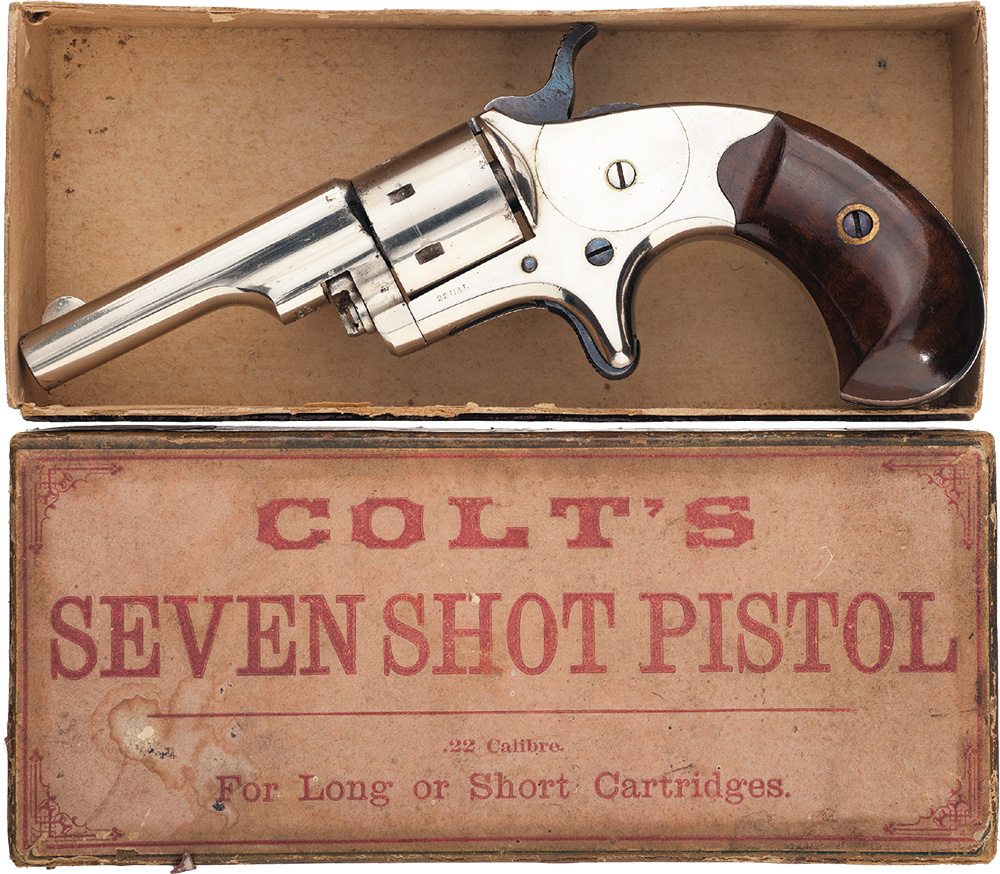
It is worthwhile to remember Oscar Wilde’s definition of a cynic, quoted also by C. E. Chapel in his handbook, as one who “knows the price of everything and the value of nothing.” You may value a revolver in very good condition that fills a void in your collection beyond any book value. Finding such a piece is an exciting discovery and a thrill that cannot be calculated in dollars.
Interest in the small .22-caliber revolver field is increasing, but fortunately prices have not gone upward quite as rapidly as have many others of makes and types.
If you select this area as your specialty, you will find prices range from $20 to $50 for most makes, with such better-known and higher-quality names as Colt, Remington and S&W bringing $75 dollars or more. First models, obviously, are worth more, but few values have gone over $200, at least not so far!

Be discriminating about the condition of any antique revolver you contemplate buying. There are several “musts.” All parts should be intact and the gun in good working order. While some nicks and age marks are to be expected, 80 percent or more of original finish, with the markings sharp, is required to qualify as excellent. In some cases a patina or thin coating of age over the finish is found. Do not attempt to remove this for you would destroy the character of antiquity.
A sanded or buffed gun, one newly plated or brilliantly brightened, will have lost value, often drastically. Leave ‘em alone!
Your first inclination on acquiring a revolver of 1880 may be to disassemble it. In a word, don’t. The integral parts have operated for almost a century without your probing screwdriver and only harm can result from your efforts.
Oil lightly if you wish, but leave the piece intact. If operation problems occur, try to find an “exploded” or isometric drawing of the model. Then, and only then, should disassembly be attempted—and make sure your screwdrivers really fit. The general rule in the care and repair of antique models is “the less done, the better.”
Before buying that first antique .22, you should know and comply with the gun laws of your particular city and state. In many cases, antique guns (those manufactured prior to 1898) are exempt from regulations applied to modern guns. It is best, however, to have whatever registration is required before doing any buying. Your collection might include a gun made in 1899 or later, or you might be called on to prove date of manufacture of a borderline piece.
With knowledge of values, or at least prices, you are ready to begin your search. Your local gun store may deal primarily in new or current model handguns with a stray antique offered only occasionally. Where then can you look?
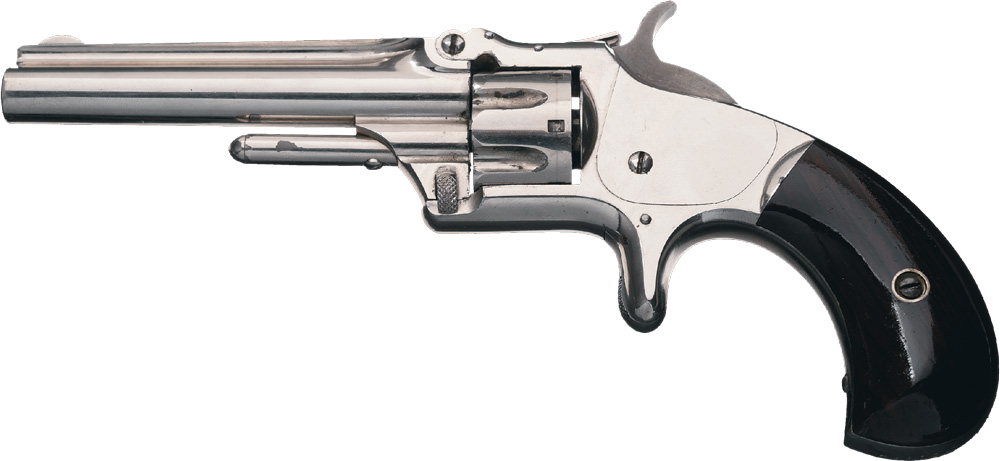
When you have acquired several specimens, you will begin to appreciate the reasons that led you to select the antique .22 revolver as your specialty. Although somewhat similar in overall appearance, you will discover interesting variations in the cylinder construction, barrels and cylinder pins, and grips and side plate versus solid-frame construction. Like people, each make has its own characteristics.
Storage of these small, compact guns is relatively easy. A tool chest with two shallow drawers is perfect. Line the drawers with a soft-finished, yet firm cloth, and you’ll have storage for a dozen or so guns. The top area is ideal for tools and parts.
As each succeeding gun is located and added to your collection, your knowledge and mechanical abilities will increase. The pride felt in learning these things is hard to explain, but you’ll find that a new facet has been added to your life activities. In time to come, you may even set down to write pieces like this!
Beyond the true joy of watching your collection and knowledge grow is the health-giving therapy of being totally immersed in your hobby, which often shuts out those everyday problems and worries.
As every collector knows, the peak thrill is the excitement of a rare find, at the right price, that fills a void in your collection. I defy you to match the chill that overcomes you as you spot that rare gun.
You may find it hard to convince your wife that these $30 expenditures at various times are worthwhile. If you do, point out to her that antique guns are always a diminishing quantity through destruction by intention or accident. Demand, however, is always increasing as new collectors join the gun field. More demand, less supply means rising prices in years to come.
A representative collection of these small guns provides a historical picture of the 19th century developments leading to our modern-day cartridge handgun. The world of the antique .22-caliber revolver is a great area for a collection specialty. Come join me!
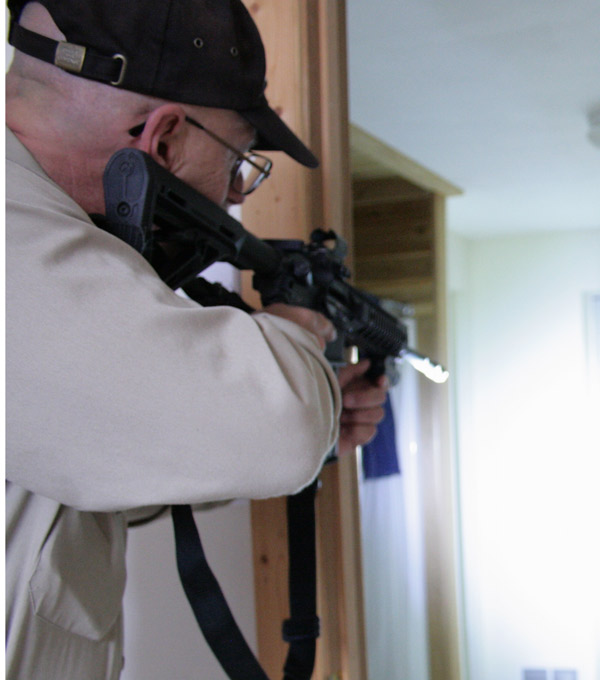
When it comes to an AR-15 that I plan to use exclusively for defensive reasons, there are really only two items I like to add to the gun: some sort of white light and a sighting device other than iron sights. I don’t have anything against iron sights, but in low light situations, they can come up short. There are a many other extras that can be added to a tactical rifle, and special operators may even need others for a particular mission, but the simple AR with these two necessities is not only all a guy needs, but may prove to be tactically superior to a rifle with a bunch of additional items strapped on.
Choosing Your Sight
As far as a sight is concerned, I like the red-dot types. For my high mileage eyes something like an EOTech, AimPoint or one of the mini-red dots really improves my speed in lining up on target—particularly in low-light situations. Another great option for the defensive rifle is one of the 1.5×5 scopes that can be like a red dot on low power, but also offers some magnification for longer distance shots. Leupold’s MRT is a great choice in this department.
Depending on your intended use, this might even be a better choice, but for most home defensive and close-quarter situations, a red-dot or iron sight will be a better choice. Remember, it’s not outside the scope of operation to make long shots with a red-dot or iron sights, particularly with good eyes and practice so don’t discount these options just because you expect to shoot farther than 50 or 100 yards now and then. My patrol rifle is topped with an unmagnified EOTech and it’s capable of accurate 300-yard connections.
I had an opportunity to try out a medium-sized red dot from Meopta recently—the M-RAD, which proved to be a rugged little unit that can be used on a Picatinny-railed AR without a lot of added weight. It has a heavy hood to protect the optic and the on/off button is on the forward side of the sight for easy manipulation when shouldering the rifle. The same button can be manipulated when the sight is turned on at the shoulder to get the brightness appropriate for conditions.

The unit comes with a pocket-sized wallet with all the tools and extra mounting pads to get the correct height for the individual shooter. The battery cap can be removed with a coin, but it’s easier to take off with the provided tool. The sight can be quickly put on and taken off the rifle with a robust clamping lever. The lever also has a spring loaded safety to keep it from coming off during rugged use. This would make swapping it out with a scoped sight easy in the field if the mission dictates.
It was literally a snap to mount it on the SIG 516 Patrol rifle I was shooting, and within seconds, I was on the range sighting it in. The tool wallet has a small screwdriver for adjusting the sight making elevation and windage corrections easy. Within a few shots I was sighted in. On the AR platform, the shot will hit low on close quarter shots because the barrel is a few inches low of the sight. At 100 yards it was dead on.
I ran it through some quick double taps around a barricade and the sight jumped right to the target. In fact, it was easy for me to double tap inch and a half groups. The M-RAD would also be small enough to mount at an angle on a competition gun that bears a scope for close shot versatility.
Light Selection
With sights decided upon, it’s now time to be prepared to precisely evaluate any threat while maintaining the ultimate level of readiness. You cannot evaluate a threat properly if you cannot see it. One of the best advancements that I have seen over the years pointing guns at people in the dark is lighting.
One of the first “modern” lights I owned was a Streamlight rechargeable flashlight. It was big and heavy, but much brighter than its predecessors. Now, almost 30 years later, I still look to Streamlight for my lighting needs. The lights are smaller, brighter and have functions like strobe, which in law enforcement, we were always taught to do manually.
Streamlight’s TLR-1 HL, which I assume stands for high lumens, busts out a whopping 630 lumens of light with a pistol-sized gun light. For close quarters defensive use this light is adequate on the carbine as well as the pistol. On the rifle it doesn’t add much weight or size and will light up, or blind, anyone in the room or area you are searching. It has an easily manipulated on /off switch, which allows the user to set it to momentary, all-on or strobe illumination.
The Streamlight TLR-2 HL boasts the same 630 lumens with a built in laser, which could be an alternate sighting device on your carbine or pistol should the condition dictate. Normally I’m not a fan of lasers, but for no extra weight or convenience, a laser can be waiting for duty should you need to make a shot without a sight picture. I mounted this light with Streamlight’s quick mount on the bottom rail of my AR. It was amazing how well it lit up any room in the house or outside around the house. I could evaluate a person’s hands at 25 yards easily.
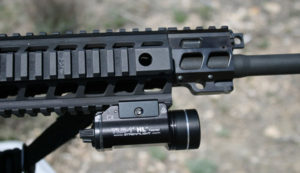
This light also snaps on the duty pistol rail and is easily manipulated with the weak hand thumb or first finger. The 630 lumens really lights up the search area, and there is enough ambient light to see the sights as well when using open or other iron-type sights. I remember searching buildings in patrol back in the day with lights that were the brightest available, but were dismal at best compared to the products we have now.
The amount of light emitted by these new units in such a small package is unbelievable. I lit up an area around where my new shop is going in from 35 yards away with the TLR-1 on a carbine and it made everything in the area stand out as if it were in daylight. The smaller pistol/carbine light brightens up a bigger area than the beam oriented rifle light they also offer. This is great for searching as it gives plenty of peripheral vision around where the carbine is pointed.
Streamlight makes a version of the TLR-1 light in a rifle format. The unit is similar, but the lens is more suited to sending light in a beam for longer distance target identification. They also make it with a green LED for hunting as the green light is less spooky to game. I thought the green light would be less bright as the distance increased but it illuminated my 100-yard target board with ease. The center of the beam is bright and through a scope the target has plenty of light for a shot. Both of these units are extremely rugged and I have abused them both on purpose without a fail. The units take two of the CR123 lithium batteries that provide 6 volts of power behind the LED.
Either of these lights can be mounted on the Picatinny 4 rail forearm in any position that is comfortable to the shooter. I like mine on the bottom. The activation button is ambidextrous, and I use my index finger on the right side to operate the light. This gives me a comfortable grip on the forend of the gun, and I have light when I need it. Streamlight also makes an attachment for the back of the unit that has a pressure switch wired to it so a user can put the switch anywhere else on the gun that suits them.

I haven’t used the green light on game, but the white light version seems to stop coyotes in their tracks. I think they are mesmerized by the brightness of the light. The green light really lights up the area out plenty far for a calling shot as I tested it on my 100-yard target. It’s kinda like using a Generation 1 Night vision scope, but the image is clearer. Both of these lights operate on lithium batteries. The run time on the light at 630 lumens is 1.25 hours and the laser if equipped has a runtime of 45 hours. One thing nice about a battery unit is when batteries start to weaken, it’s just a matter of putting fresh ones in. Rechargeable lights don’t give the operator that option.
I really like both of these lights and I’m sure one day they will even be dim compared to the new fangled creations they come up with in the future. But for now, paired with a good red-dot sight, I feel I have everything I need on my AR to safely defend my home.

Back when I was young, I didn’t fully understand what Dad meant when he said the best part of deer season was getting ready—the week leading up to gun season and the excitement of preparation. Sitting on a cold stump and staring at trees was not as much fun, he said. I thought he was just being a curmudgeon; he turned out to be the voice of experience.
In a similar vein, the late Dan Shideler (who edited the Gun Digest annual book and Standard Catalog of Firearms) said he’d got almost as much enjoyment from reading about guns as shooting them. I thought about this parallel as I sat there on opening morning trying desperately to keep warm by forming my little hand warmer packet into all sorts of fun shapes.
That’s when it struck me. I’d crossed the Rubicon. It must have been the near hypothermic condition into which I’d gradually slipped that made me see the wisdom of those who had gone before. Yes, a warm house and a good gun book started to sound damn good!
Now, nothing makes you appreciate that warm house more than an all-day sit in a frozen ground blind as you watch your dreams of a big buck evaporate like a desert mirage.
Not helping matters: Quite possibly the coldest Wisconsin deer season ever recorded, at least since the last ice age. So I sat shivering, feeling like part of some weird experiment in human endurance. I thought of Jack London’s novel, To Build a Fire, the horrific story of a Yukon gold panner who gets caught in the sub-zero arctic and slowly freezes to death because his fingers stop working. That didn’t inspire any happy feelings.
It did make me relish the annual pilgrimage to the local Fleet Farm the day before. You see, that was the getting ready part. It was the warm part.
Sometimes, there in my blind, I’d just stare at the beautifully figured stock of my .280, and take my mind off the cold pain for a split second. But then the ache would creep up each finger as the nerve endings began to freeze again.
Eventually, a deer would mosey on by. Its luck would run out. The rifle would get to do what it was designed to do: Shoot game.
This tool, fashioned from wood and metal, works like a precision clock whose internal gears and windings all do their part to produce the end product of time keeping.
The rifle’s trigger assembly actuates the firing pin. The pin ignites the primer, in turn the powder. The bullet is driven with a precise amount of pressure down the bore. The exacting tolerances deliver the bullet down the scope’s path to its intended target.
All time and space comes together right here: Intricate systems meeting a wild animal in one place. All have to work in order for man to eat.
The shot happens, and wonder of wonders; I’m no longer cold.
With the deer down, there follows hard work—gutting, dragging, lifting, hoisting and butchering.
Later that night, in a warm abode (the couch, tucked under five blankets and two comforters), with a hot chocolate milk in one hand and a good gun book like Gun Digest 2014 in the other, there is only one thing left to do—reflect.
Here is warmth and comfort, an opportunity to think back on the day’s hunt. I open the book and find only good things. No cold, no hard work, just page after page of reading enjoyment and wonderment—like an endless catalog in which a gun owner (a warm, comfortable gun owner)—can window shop and dream.
Dad, and Dan, both gone now, were sure right. The day before the hunt. A good gun book. These gems are almost as good as the real thing. Well, almost.
Recommended Links for the Gun Digest Annual Book
 Click Here to get your copy of the Gun Digest 2014
Click Here to get your copy of the Gun Digest 2014
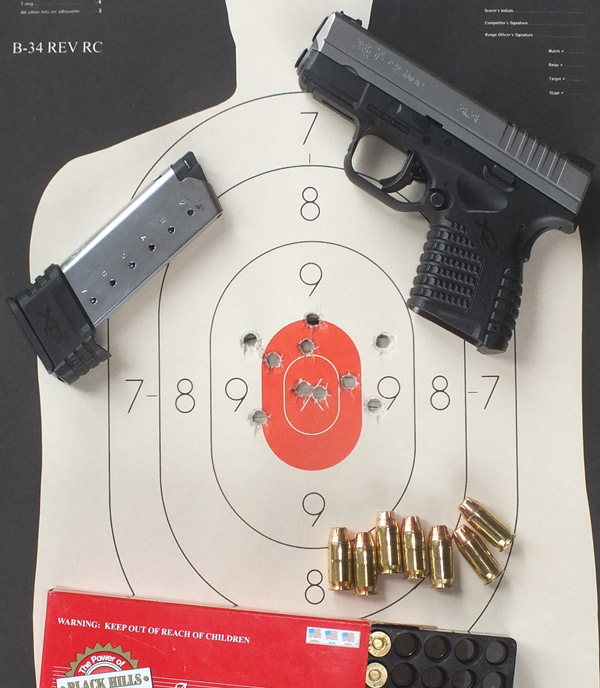
These folks see the value of firearms ownership as a way to take a proactive part in defending themselves against crime. They are refreshing to teach because their minds are open and they’re willing to accept new methods and equipment.
There’s a whole generation of new pistols for concealed carry, and I’m impressed with the thought and engineering that’s gone into many of them. Recently, I assisted in a test of four .45 ACP single-stack concealed carry semi-autos. I was impressed with the XDs then and when I got a chance to test one myself more extensively, I jumped on the opportunity.
Springfield Armory’s line of XD pistols has been a smashing success. The features of these striker fired guns make them unique in that they are ambidextrous and feature a grip safety, a valuable asset in a striker fired gun that allows a lighter, shorter stroke trigger with a similar or greater level of safety.
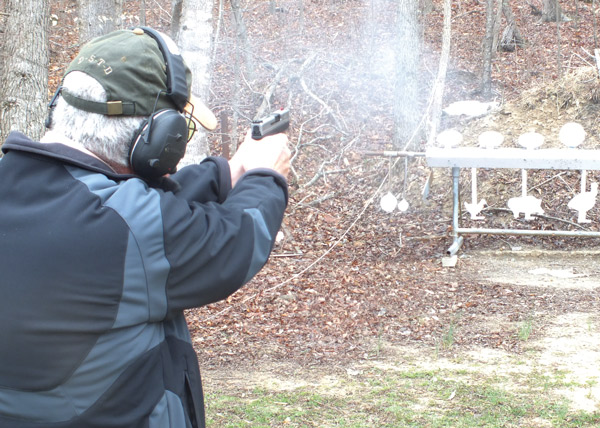
Living Up to Its Reputation
I used a Springfield XDs 5.25 in last year’s Bianchi Cup. My choice was based on the XDs’ reputation for accuracy and reliability so when my editor suggested shooting production class, the 5.25 was an easy choice.
Made in Croatia and parented by the first Croatian pistol manufactured, the PHP, the XD series of pistols have become viable contenders for the civilian as well as police and military markets. My XDm has yet to malfunction through thousands of rounds.
Like other XD series guns, the XDs is well finished for a utility gun. The controls are similarly placed with the takedown lever and slide release on the left side and an ambidextrous magazine release. The sights are really good with a driftable two-dot rear and a hi-vis front. The trigger is indistinguishable in pull from the larger XD pistols, which is to say it is very good. There is a fairly short initial travel and a distinct second stage that breaks consistently and cleanly.
The standard magazine holds five rounds and there’s an available extended seven round magazine. While the seven round magazine is handy for range use, it increases the profile of the gun considerably. With one in the chamber, 6 rounds is reasonable in a concealed carry handgun. If you can’t do it with six, you should practice more.
Striker fired, with no manual safety, the XDs relies on a blade in the trigger and a grip safety to prevent accidental discharge. Carrying a round in the chamber is, in my opinion, a prerequisite for using a semi-auto for concealed carry and with a holster that protects the trigger, I’d feel perfectly safe carrying this gun with a round chambered.
At 21.5 ounces, the XDs is not a lightweight. With a loaded magazine, it approaches the empty weight of some service level pistols. While it occupies about the same profile as a J frame S&W, it weighs more empty and considerably more loaded.
What this pistol has going for it is that it’s a .45. It is thinner in profile than a small revolver and it carries a lot more punch. That punch also translates itself into recoil. In a recent range session where I fired 300 rounds with the XDs and a couple of other compact .45s, I managed to escape without having a sore hand the next day, but this is not a gun for the fainthearted.
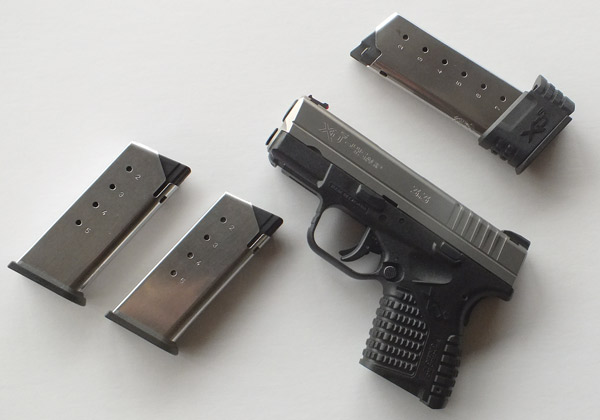
On the Range
Operation of the XDs is both simple and convenient. The magazine is fairly easy to load, the slide operates well and may be easier to manipulate than some of the larger XD series guns with slides that taper towards the top. The controls are where they should be, making the gun easy to adapt to. With a good trigger and good sights, I expected it to perform well, and I wasn’t disappointed.
I don’t bench test carry guns because the short sight radius makes it difficult. My test is to determine reasonable accuracy for the purpose for which the gun is intended. At 10 yards, two hands, with a magazine change, I managed a 2.5 inch, 10-shot group that was centered in the target. Recoil recovery is slower than larger or less powerful guns, but it was reasonable and the good sights and trigger aided greatly. I fired this with the five-shot magazines because I see the seven shot magazine as too large for every day concealment.
Overall, this is a very good concealment gun for those who feel the need for serious power. It’s larger and considerably heavier than the gun I carry every day, but every aspect of concealed carry firearms choice is a tradeoff between effectiveness and concealability.
This gun is as powerful as any concealed carry gun needs to be. It’s also extremely reliable and accurate. It’s also quite safe to carry in normal carry situations. It’s not a gun for those who have problems dealing with recoil. Once loaded, it’s heavier than I’d want to carry every day, but you simply can’t argue with a gun this small with this kind of power and accuracy.
Springfield Armory XDs
Caliber: .45 ACP
Capacity: 5 + 1, and 7 + 1 with the extended magazine
Magazines: Two aluminum five round furnished with the gun.
Barrel: 3.3 inches
Sights: Steel Dovetail rear, drift adjustable with white dots, front fiber optic.
Frame: Polymer
Slide: Forged Steel
Length: 6.3”
Height: 4.4”
Weight: 21.5 oz.
Options: Seven round extended magazine
Suggested Retail Price: $689
Website: springfield-armory.com
You’ll appreciate this guide to the use of lethal force if:
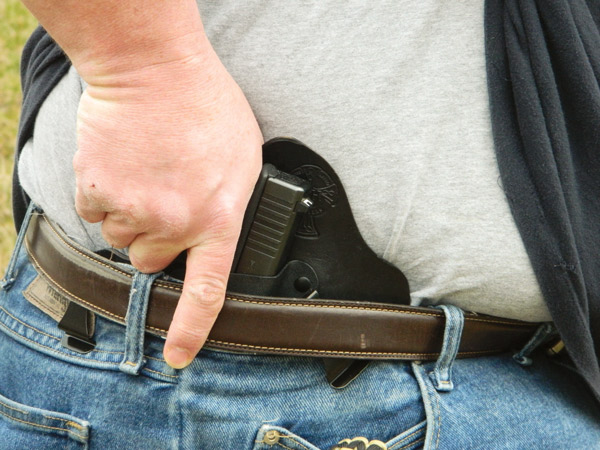
Choosing to carry a concealed handgun for self-defense is a good start to being prepared for an attack, but simply carrying a gun isn’t enough. You also have to know how to use that gun.
The basics of shooting and marksmanship are quite simple—grip, sights, trigger control and follow through—and can be easily learned. More advanced gun handling skills can be learned through research, or by attending one of the many firearm academies across the country.
While gun handling and accuracy skills are important, if you can’t get the gun out of the holster and into action quickly, you’ll be standing there with a lot of knowledge in your head and nothing in your hand. This makes the draw one of the most important components of proper self-defense. And you must be able to make the draw at any time and from any position.
Understanding Technique
Now before developing your draw, you have to decide how you’re going to carry. Some methods of carry provide easier access, while others impart deeper cover. There is no single correct way to carry a gun and only you can decide the method that works best for your purposes. But regardless of how you carry, you must master the draw for the holster system, or systems, that you choose.
The standard draw consists of four simple motions—the grip, the pull, the rotate and the presentation—that must be conducted in sequence or the entire process disintegrates and problems arise. Everything in the draw begins with the grip.
When you reach for your handgun, you must instantly obtain a shooting grip, with the trigger finger aligned along the frame. If you don’t get a firm grip on your handgun before it exits the holster, the draw can be fumbled and the gun dropped, which won’t do any good and could very well cause a lot of harm. You then pull the gun straight out of the holster before rotating it toward the target—from here, you can fire if the attacker has gotten too close to fully extend the gun. Finally, you present the gun toward the target, allowing the support hand to come up into a two-hand shooting grip as the sights line up.
Developing the Proper Draw
Now the problem with the standard draw is that it is based on carrying a gun in a strong-side holster, and there are as many different ways to carry a gun as there are types of handguns to carry. Fortunately, the draw is basically the same in all cases, with some minor variations.
Developing a proper draw takes time and practice, especially if you carry in multiple ways, as you must always be aware of where your gun is located and the best way to get that gun into action. You must develop the muscle memory for each and every way you carry. This is one of the reasons that many experts recommend carrying the same gun in the same way all the time. It doesn’t matter how good a shot you are if your gun is sitting in your holster.
The choice of carry method can also determine whether you can practice drawing at your local range. While some ranges do not allow draw training at all, others limit it to those methods like strong-side, pocket and ankle where the shooter is not sweeping the muzzle across adjacent areas. Unless you have your own range or shooting area, it’s very difficult to obtain live-fire training with cross draw, shoulder and small-of-back set ups. Availability of training locations should be included when considering how to carry a concealed handgun.
Few American holidays have a closer relationship to a particular firearm than Thanksgiving. Next to turkeys, Pilgrims and Indians the tried-and-true blunderbuss is one of the celebration's most recognizable symbols. But the unmistakable gun was more than just a tool used to put meat on the table. The blunderbuss — Dutch for “thunder pipe” — was also a merciless weapon favored by pirates, cavalries and colonial militias. Check out the following videos to brush up on some of the finer points of the blunderbuss and, of course, watch a few people drop the hammer on the gun.
NEXT PAGE
The National Firearms Museum gives a short history of the blunderbuss, with a Spanish Miquelet as its example.
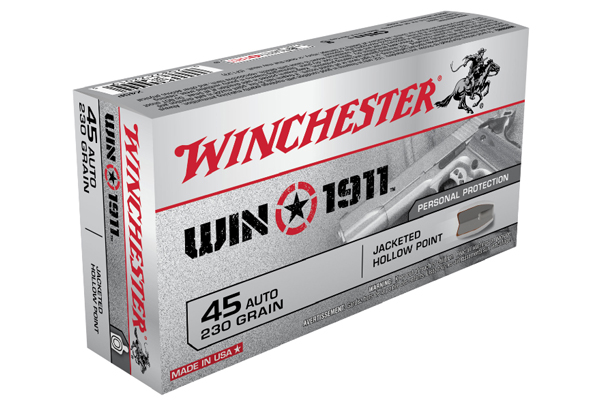
Of the many firearms designs emanating from John Browning few have become as ubiquitous and storied as the Model 1911.
The single-action semi-automatic pistol became one of the most popular handguns of the past century, having earned its stripes on some of the world's most brutal battlegrounds. Since then, it has gone on to be the choice of every type of handgun enthusiast — from those looking for a personal-defense piece, to plain old plinkers. The 1911's acclaim has even led nearly every major manufacturer to produce their version of the pistol — a claim few designs can make.
Now, a company aims to give its take on the handgun or at least its ammunition. Winchester has just released Win1911 line, ammo the company has tailored specifically for use in the historic pistol.
Winchester is offering two new rounds in the line, both in .45 ACP — a flat nose full-metal jacket and a jacketed hollow point option. Both the FMJ and JHP rounds have nickel-plated jackets, a feature meant to facilitate cleaner feeding in a handgun known to sometimes have finicky ammo tastes. But it is not the components that are the intriguing aspects of the Win1911 line. It's the rounds' ballistics.
The FMJ and JHP have identical ballistic performance, both capped with 230 grain bullets and boasting the same muzzle velocity. The clone rounds are meant to give shooters seamless ballistics from practice to application, allowing them to chamber a self-defense round that performs in similar fashion to the round they'll punch holes in paper with at the shooting range.
The idea behind the Win1911 line seems solid, but only time will tell if it becomes as iconic as the pistol itself.
| CALIBER | BULLET | BULLET WEIGHT | VELOCITY |
| .45 ACP | Full Metal Jacket | 230 grain | 880 fps |
| .45 ACP | Jacketed Hollow Point | 230 grain | 880 fps |
 Some folks like to dabble in all of the shooting disciplines, including archery. Working off a 2006 study from the U.S. Fish & Wildlife Service that indicated 93% of all hunters hunt with firearms and 28% hunt with a bow, Stack-On came up with a security cabinet for hunters that houses both guns and bows.
Some folks like to dabble in all of the shooting disciplines, including archery. Working off a 2006 study from the U.S. Fish & Wildlife Service that indicated 93% of all hunters hunt with firearms and 28% hunt with a bow, Stack-On came up with a security cabinet for hunters that houses both guns and bows.
The Buck Commander Gun & Bow Security Cabinet was designed to hold two compound bows and up to eight rifles or shotguns. The weapons are locked behind 3-point, key-coded system and the steel exterior has a Hammertone black and silver paint finish. Inside is a full-width, steel shelf for ammo or gear and on mounted on the door is a foam holder that holds 12 arrows. There is also hanging peg that attaches to the outside of the cabinet for hanging a bow—a handy feature for when your hands are too full.
“There is nothing else like it in the marketplace today,” said Shelley Nehrt, Director of Marketing for Stack-On Products. That is a true statement and the cabinet is perfect for the shooter that likes to send bullets, shot and arrows downrange. The specs: 21” wide, 18” deep, and 55” tall. Visit Stack-On.
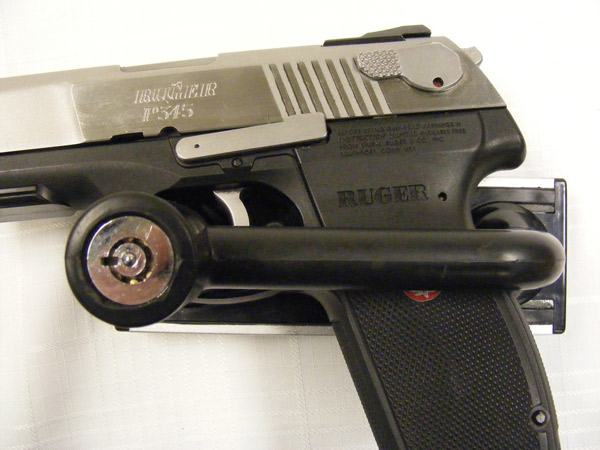 Rather than locking a firearm inside of container to keep it safe, another option exists: lock the gun through a mechanical device and simply leave it out in the open (or hidden if so inclined). This is what the RAC does for firearms that are not in use. It has both a trigger lock and a tamper-resistant mounting system that can withstand 4,700 pounds of pressure.
Rather than locking a firearm inside of container to keep it safe, another option exists: lock the gun through a mechanical device and simply leave it out in the open (or hidden if so inclined). This is what the RAC does for firearms that are not in use. It has both a trigger lock and a tamper-resistant mounting system that can withstand 4,700 pounds of pressure.
What is interesting about the RAC is that it can be mounted on just about anything and anywhere. It can be bolted underneath the hood of a trunk so when you open the trunk, there is your gun. It can be mounted about anywhere in your home, garage, barn or work area. The only caveat is that whatever you mount the RAC onto; it should be just as strong since the surface material will probably break before the RAC will if a vandal were to try and smash it off a wall. But even if that happened, then the criminal will have a useless gun with a lock stuck on it. Hence, only a true idiot would attempt such a thing.
Mounting the RAC is about as hard has hanging a bookshelf. Mark where you want to put it with a pencil, drill the holes, and wrench in the lag bolts. There are some special instructions for removing a pin and they are easily understood.
The RAC secures about 97% of firearms with a trigger housing and has earned California compliance certification. It can fit both long guns and handguns and so they won’t get scratched, it is covered with a smooth rubber coating. A tubular key is used to access the gun and the manufacturer recommends storing only unloaded firearms. Two kinds are offered: a three-inch model that stores one firearm, and a five-inch model that can hold multiple firearms depending on their size and shape. MSRP: $75. For more information visit The RAC.
Negrini has rolled out a new line of gun cases called Tactica Concealed Carry. On the outside, they look like a sleek and stylish case that could hold anything. On the inside are modular, transformable inner sections of dense die-cut PixelFoam. That means you can swap out this sections like Lego parts to fit whatever gun or accessory you need to make a tight, secure fit. The user removes the unused pixels in whatever way you want to fit your firearm and additional pixels can be ordered for further customizing or if you lose one.
The cases come in eight sizes ranging from a single handgun case to one that holds six. There are also cases for AR-15-type rifles. All sizes of the cases have extra room for magazines and accessories. The exterior of the cases are made of a double wall multi-layer ABS technical polymer that is lightweight and absorbs shock. The MSRP ranges from $119 to $369. Check out Negrini Cases.
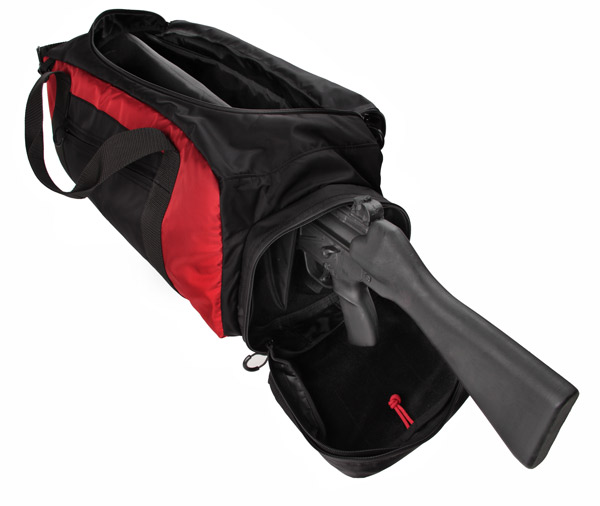
Firearms transportation can be tricky, even more so in a discreet manner.
BLACKHAWK!, however, has made getting your gun from point A to point B less of a hassle. The shooting and tactical gear manufacturer has introduced an inconspicuous option for moving around your firearms, even in the most delicate situations.
BLACKHAWK! Diversion bags barely raise an eyebrow, mimicking everyday backpacks and bags. The full line of customized bags and packs prevent drawing unwanted attention, giving gun owners low-profile weapons storage, retention and transportation capabilities.
The Racquet Bag, Workout Bag, Range Bag, Courier Bag, Carry Sling Pack, Carry Backpack, and Board Pack use common color schemes and popular designs that enable secure and safe transportation. The luggage keeps firearms hidden in plain sight.
Discreet and Convenient
When the situation dictates off-body carry, quick and easy access to a firearm is essential. With the Diversion Carry Sling Pack and Diversion Carry Backpack, access is only a zip away. Both packs offer lockable, two-way zippers and come with a Universal Holster for optimal firearm placement. These small packs can accommodate just about any handgun from a J-frame to a full-size Beretta 92.
Everyday Look with Intelligent Options
The Diversion Range Bag and Courier Bag offer a wide variety of options for carrying range supplies and personal protection needs. The Range Bag appears as a common gym bag but features two hidden handgun compartments and two pockets for magazines or gun cleaning supplies. A side compartment conveniently opens to provide a gun rug for cleaning and maintenance.
The Courier Bag’s customizable front pocket allows for multiple configurations, including storage of four AR-15 mags and a single pistol mag or four M14 magazines. A pass-through zipper in the lid gives quick access to the main compartment, which contains numerous loops and pockets for accessories, radios and additional pistol mags. The hidden handgun compartment provides ambidextrous access for added versatility.
Casual, but Concealed
At just the right length, the Diversion Racquet Bag, Diversion Workout Bag and Diversion Board Pack allow discreet rifle storage and transportation. Accommodating rifles up to 29 inches in length or AR platforms separated into upper and lower receivers, these bags blend into the surroundings without drawing unwanted attention.
The Racquet Bag’s padded outer walls prevent printing while internal dividers provide protection for the rifle. With an interior lined in S.T.R.I.K.E. webbing and internal divider, the Board Pack allows for attaching holsters, pouches and accessories next to a rifle for quick access. The Workout Bag’s ingenious design features internal loop sections for additional hook-back pouches, holster and accessories. The main compartment extends into end pockets for carrying multiple firearms or separate upper and lower receivers.
Recommended Concealed Carry Resources
 Gun Digest Shooter's Guide to Shotguns
Gun Digest Shooter's Guide to Shotguns
The speedloader really comes into its own when paired with the Universal Revolver Reload. With one hand holding the cylinder and the other handling the speedloader you can take advantage of proprioception; all you need to do is to bring your hands together and the speedloader will be right on top of the cylinder where it needs to be.
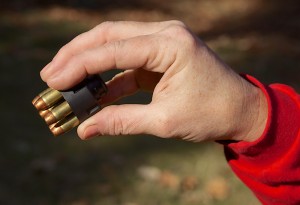
Reloading in the dark or while keeping your eyes on your threat is more efficiently accomplished with the speedloader than with any other method.
Like anything else, there is a technique to using the speedloader. Poor speedloader technique can slow the reload significantly. Here’s what I’ve found to be the best way to use one.
When you retrieve your speedloader, it’s important to grasp it by the body, and ideally so that your fingers align with and extend just past the bullet noses. This slightly enhances the effect of proprioception and makes it easier to handle the speedloader. If you don’t get it exactly right, don’t worry; the technique won’t fail if your fingers aren’t in exactly the right place. The most important thing is to grasp the speedloader by the body, not by the knob!
As you bring the hand with the speedloader toward the one that is holding the cylinder, proprioception ensures that the speedloader will naturally end up over the chambers. Just bring your hands together.
(Some trainers advise, and I used to teach, that the tips of your fingers can make contact with the edge of the cylinder to help align the rounds with the chambers. I’ve found that’s not necessarily true, particularly if your initial grasp of the speedloader doesn’t leave your fingertips in front of the bullet noses. Instead, I now teach to simply bring your hands together – the speedloader will be in just the right position automatically.)
Sometimes you’ll get lucky and the bullet noses happen to line up with the chambers; other times they’ll line up on the metal between the chambers. The solution is simple: as the bullet noses come into contact with the cylinder, simply jiggle the speedloader by twisting it very slightly and very quickly clockwise and counter-clockwise. The bullets will drop into the chambers without further work on your part. (This is a fine motor skill, which validates my insistence on using your most dexterous hand to do the job.)
After the rounds have dropped into the chambers, release them by whatever method your speedloader brand requires. If you’re using a Safariland or SL Variant, simply push the body of the speedloader toward the cylinder and the rounds will release.
If your speedloader is an HKS or similar design, insert the rounds into the cylinder, then grab the knob and twist it to release the rounds.
As the rounds drop from the speedloader, pull it straight back out to make sure all of the rounds have cleared, then drop it over the side of the gun. This eliminates another failure point of the reload procedure: rounds binding in the loader.
It’s not uncommon to have the speedloader tilt just a bit and cause a round or two to bind inside the loader. When this happens the round(s) don’t clear the loader, and if you attempt to close the cylinder you’ll trap that round(s) and the speedloader against the frame of the gun. You’ll then need to open the cylinder, grab the speedloader, shake the round(s) loose and finally finish the reload. Yes, it’s time consuming and aggravating, which is why I strive to avoid it by lifting the loader and allowing the rounds to drop free, then tossing the speedloader away.
The two most common and widely available speedloaders on the market are the Safariland, which use a push-to-release mechanism, and the HKS, which releases by turning a knob. (There are other examples of each style, such as the push-type SL Variant and the turn-type Five Star, but Safariland and HKS are by far the most readily available. They’re the least expensive in their respective categories as well.)
In general I much prefer the Safariland, simply because they’re more intuitive in use. You’re already grasping the speedloader by its body and pushing the rounds into the cylinder; releasing the rounds from the Safariland is a simple continuation of that movement. The HKS style, on the other hand, requires you to release your grasp of the body, find the knob and grab it, then twist it in the proper direction to allow the rounds to drop into the cylinder. I don’t consider that as intuitive as simply continuing pushing the way you’re already pushing.
I’ve also found that the Safariland speedloaders, when properly loaded, are more secure. They’re less likely to accidentally release in a pocket or when dropped.
This article is an excerpt from the new book Defensive Revolver Fundamentals by Grant Cunningham. Click here to get your copy.

Taran Butler has made a name for himself as a top shot on the 3-Gun circuit, a member of Team Benelli and an instructor for Hollywood actors. Below is an excerpt from an interview Butler did with Barb Baird of Women's Outdoor News. The big question Baird had for someone who lives in his range bag, what exactly is in it?
Trainer of the stars and dubbed one of the most versatile competitive shooters in the world, Hollywood’s Taran Butler is a no-nonsense, get-it-done-now guy. You might know him as one of Benelli’s 3-Gun pros, and he has collected multiple championships, including the Rocky Mountain World 3-Gun tactical champion (three times) and SMM 3-Gun Tactical Champion, 11 times consecutively.
During the height of his current competitive season, Butler took time to reveal what he carries in his trusty range bag, made by Green Mountain.
“I have been using the Green Mountain bag since 1996, and it’s awesome—not overly big or too small, and it can handle brutal baggage handlers. It’s by far the ultimate bag,” said Butler. For 3-Gun matches, Butler shoots a custom TR-1 ULTIMATE AR-15, TTI Glock 34, TTI ulti-mate Benelli M2 and a custom Infinity 1911.
Here’s what you’ll find in his range bag:
- Infinity 1911 24-round magazines
- BLADE TECH holster belt and mag pouches
- Federal and Black Hills ammo
- Tools and replacement parts
- Pro Grip spray
- Oakley glasses, Vltor fitted hat
- 4-shot shotgun Kaddys
- Aquafina water, vitamins
- PMags
Editor's note, the NRAblog.com was the source for this story.
Since 2011, there has been all sorts of scuttlebutt about what happened to Strum, Ruger & Company’s Red Label Shotguns.
Some in the shotgun world insisted poor sales forced the company to abandon the 32-year project. Other smoothbore fans were just plain left scratching their heads as to the model's whereabouts.
After nearly 3 years off the shelves and out of the catalogs, Ruger has set the record straight on where the Red Label had disappeared. It seems the scattergun went back to the drawing board for an overhaul. And recently the company unveiled where its engineering efforts went in retooling its well known shotgun.
Ruger has re-released the Red Label in a 12 gauge version and has made a number of tweaks it's certain will make it a smoother shooting and more effective shotgun.
The shotgun has a redistributed center of gravity for even greater instinctual swing and pointing. It has two-inch extended forcing cones and maximum back-bored barrels. And the shotgun's soft Pachmayr® buttpad enhance the shooting experience with reduced recoil.
The Red Label’s familiar, low profile receiver reduces muzzle climb because the centerline of the bore is closer to the gun’s center mass.
It also features an American Walnut stock with a 1.5-inch drop at comb and a 2.5-inch drop at heel. Red Label shotguns are available with 26-, 28- or 30-inch barrels and each model features a 14.5-inch length of pull.
The new models retain the Red Label’s classic lines and good looks, which are further enhanced by the new stainless steel top lever. The suggested retail price for all three models is $1,399.
Each shotgun includes a custom molded, semi-soft case, five Briley chokes (two skeet chokes and one full, one modified and one improved cylinder choke), a premium-quality Briley choke tube wrench and a safety lock.
Features:
Recommended Shotgun Resources
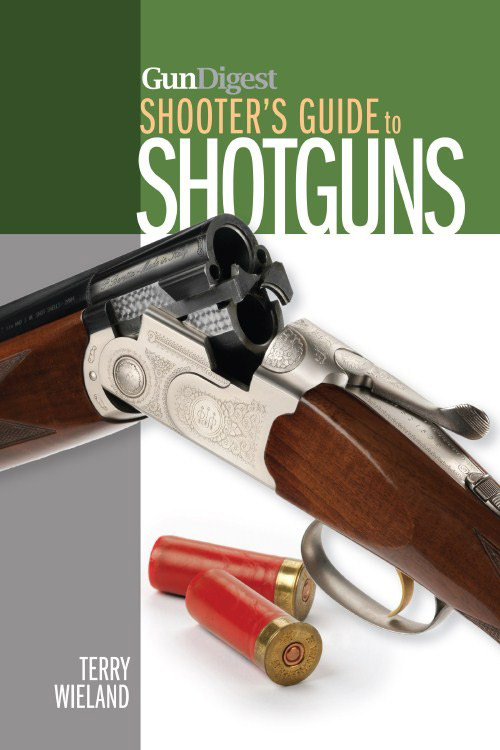 Gun Digest Shooter's Guide to Shotguns
Gun Digest Shooter's Guide to Shotguns
Gun Digest Book of Shotgunning
Some new products are simple and elegant in their design and the Snap Shot Sight is one of them. It is merely some plastic molded in the shape of a tubular figure eight with the bottom tube partially cut away.
Line up that gap on a shotgun barrel and press firmly and the sight will snap into place at the muzzle. It comes in sizes for 12- and 20-gauge shotguns and those sizes could also fit other types of firearms such as muzzleloaders or other rifles depending on the barrel thickness. It fits most shotguns including those with normal-sized ventilated ribs.
The sight is useful in two ways: fast target acquisition and accuracy improvement by forcing the shooter to keep his cheek down on the stock in order to look through the sight.
 The fast target acquisition can work as the Snap Shot frames a stationary target very well, like a circular picture frame of a turkey poking its head from behind a deadfall. This simple sight is definitely of value to turkey hunters and close-encounter varmint hunters that use shotguns (it also comes in camo).
The fast target acquisition can work as the Snap Shot frames a stationary target very well, like a circular picture frame of a turkey poking its head from behind a deadfall. This simple sight is definitely of value to turkey hunters and close-encounter varmint hunters that use shotguns (it also comes in camo).
The second benefit can be a double-edged sword depending on how you treat your shotgun: is it a wingshooting tool or used more often like a rifle? Rifle shooters bring their cheek to the stock to align their eyes on the sights. In wingshooting, the shotgun should be brought to the cheek.
And it is here where the Snap Shot gets interesting. On a crossing skeet shot, for example, if you were to frame the clay in the circle sight of the Snap Shot, you will most likely miss, as you did not lead the clay pigeon.
This is a common problem for many shooters but the Snap Shot can be turned into a tool to teach a shooter to lead a bird. It works like this: tell the shooter to swing the gun past the target until nothing but blue sky is framed in the flight path of the clay pigeon.
Instruct the shooter to only pull the trigger once empty sky is framed in the Snap Shot sight ahead of the target. That might be just enough lead to crush the clay. For shotgunners that like to experiment with wingshooting sighting aids, the Snap Shot is a great bargain. ($15, ezaccessgear.com)
Kirsten Joy Weiss isn’t just another pretty face – she's a dang fine shot.
The expert rifleman was among the most decorated competitors to ever pull the trigger for the University of Nebraska. Since her days with the Huskers, Weiss has gone on to win national championships and a spot on Lapua Team USA.
She also has taken the time to produce and star in a number of trick-shot videos that push the limits of marksmanship. Here is a taste of what Ms. Weiss is capable of when armed with a small-bore rifle and some prime targets.